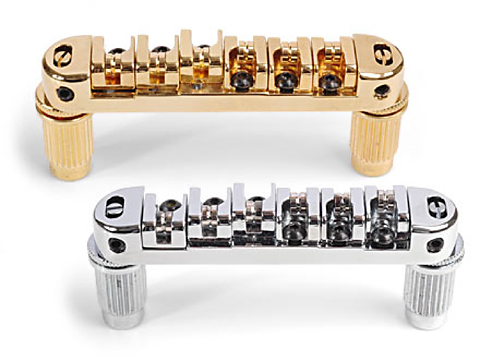A question we here at Bigsby receive quite often is that of tuning stability. In this section we offer a few tips that will help you set up your guitar. One thing to remember when setting up your vibrato equipped guitar: all vibratos (all brands and models) operate under the same set of principles. A vibrato changes the pitch of a guitar by allowing strings to go slack, lowering the pitch; or pulling the strings taut, raising the pitch. All guitars have to be set up for this operation to function properly. Another tidbit to keep in mind when using your Bigsby vibrato is that of limitations. The Bigsby vibrato is designed to fluctuate the pitch of your guitar a couple of steps, not dive-bombing 7 or 8 steps.
Step 1: Making sure that the nut on your guitar doesn’t have any burrs. A properly cut nut allows the string to move in a natural fashion. If burrs are present, gently use an appropriately sized nut file or abrasive cord to smooth out the slot. This will help the string return to proper pitch. You can also use a lubricant (pencil lead (graphite) or proprietary lubricant like Big Bends Nut Sauce) in each slot to aid movement. *Easy check to see if burrs are present: when tuning a string up to pitch, listen for ‘pings’, ‘creaks’ or a jump in pitch. It should be a smooth transition from one note to the next.
Step 2: Check the saddles on your guitar-again looking for any impedance. Just like the nut, burrs on a saddle will prevent a string from going back to its original position (in tune). If burrs are detected, a nut/saddle file or abrasive cord can be used to smooth out the slot.
Step 3: Continue your basic setup. Adjust string height (action), curvature of neck, intonation, and anything else to your personal preference. If you are installing new strings, make sure that the strings are properly stretched. See also our How To Re-String guide. Dan Erlewine’s book ‘How to Make Your Electric Guitar Play Great!’ is a great reference to aid in your setup. Erlewine offers numerous in-depth ideas and instructions to get your guitar playing to YOUR specs. The book also features many manufacturers factory setup specifications.
Common bridges used with Bigsby tailpieces:
Gretsch Rocking Bar
Floating unit, no individual saddles, rocks back and forth when vibrato engaged.

Gibson Tune-0-Matic
Both (ABR-1 and Nashville) and Stationary (non-floating), features 6 individual adjustable saddles, strings ride over saddles when vibrato is engaged.
Roller Bridges
Generally, a Tune-O-Matic style bridge but has roller saddles in place of traditional saddles. Locking models are available for extra stability.

Fender Jag/Jaz Bridge
Stationary bridge. Features six fully adjustable saddles. Generally comes with ribbed saddles. Strings glide in grooves when vibrato engaged.

Guitar nut material:
If you have already tried the tips above, this next set of information details and discusses materials and possible changes for your guitar. As mentioned above, the nut is the number one area to focus on when setting up your Bigsby equipped guitar. Yes, tuning machines and saddles also make a substantial difference, but the nut is generally where issues persist and focus needs to be directed. A properly cut and polished nut allows the string to return to its zero point (in tune) each time a string is bent or vibrato used. Aiding in a properly cut nut is the material itself. Different materials have different properties, the merits of which must be decided by the individual player.
Bone/Ivory/Horn
Bone/Ivory/Horn-has been the standard and tradition of quality instruments. Very dense and transfers vibrations well. Quality polished bone or ivory is very slippery and very durable. Some legal statutes apply to products made of these materials.

Micarta
Micarta is a thermosetting plastic high-pressure laminate comprised of different materials including linen, canvas, paper and others. Very durable and has been used on guitars since the 1960s.

Tusq
Tusq- or ‘man made ivory’. A high compression material sometimes impregnated with Teflon to aid in string movement. Said to have many of the characteristics of bone and ivory with more consistency. The addition of Teflon makes for a ‘slippery’ nut. Often used for saddles too.
Tuning Machines:
Locking tuning machines are made by a whole host of different manufacturers including Sperzel, Schaller, Gotoh, Grover and others. The basic idea behind a locking tuning machine is to lock a string in place by means other than wrapping it. This can be achieved in a few different ways including a locking string shaft cam. By wrapping a string in place on a guitar in the traditional (non-locking) way, the surface area on which it could slip is much greater. Overlapping on wrapped strings are often a point of tuning instability on any guitar. By using a locking tuning machine (any style, and brand) that locks a string in place without a single full wrap, you are decreasing the area on which a string can bind or get hung up. When using a vibrato, this becomes even more of an area of interest since you are putting slack, or pulling taut the string.


